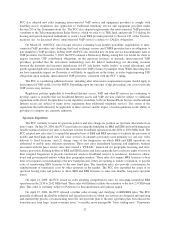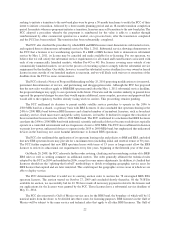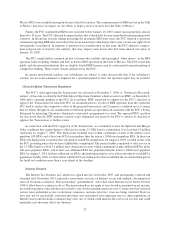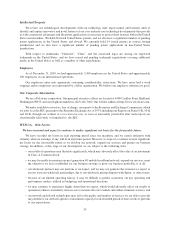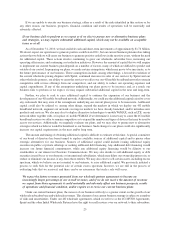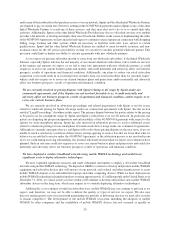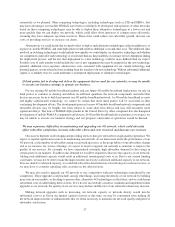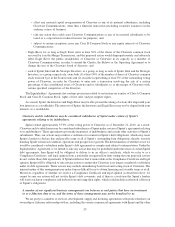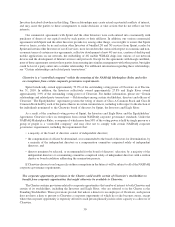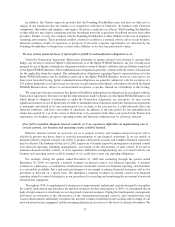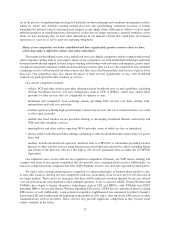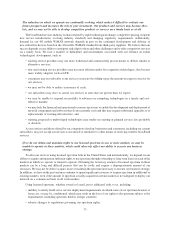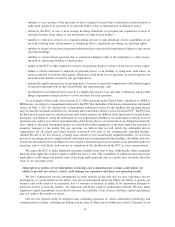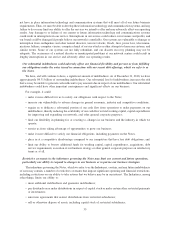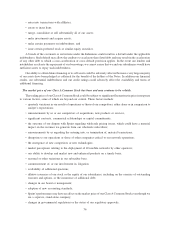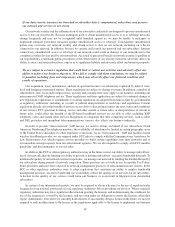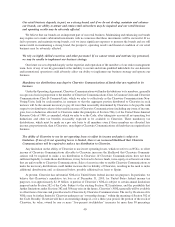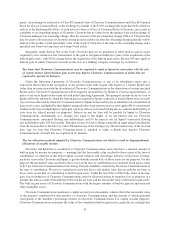Clearwire 2010 Annual Report Download - page 36
Download and view the complete annual report
Please find page 36 of the 2010 Clearwire annual report below. You can navigate through the pages in the report by either clicking on the pages listed below, or by using the keyword search tool below to find specific information within the annual report.In addition, the Charter expressly provides that the Founding Stockholders may, and have no duty not to,
engage in any businesses that are similar to or competitive with that of Clearwire, do business with Clearwire
competitors, subscribers and suppliers, and employ Clearwire’s employees or officers. The Founding Stockholders
or their affiliates may deploy competing wireless broadband networks or purchase broadband services from other
providers. Further, we may also compete with the Founding Stockholders or their affiliates in the area of employee
recruiting and retention. These potential conflicts of interest could have a material adverse effect on our business,
financial condition, results of operations or prospects if attractive corporate opportunities are allocated by the
Founding Stockholders to themselves or their other affiliates or we lose key personnel to them.
We may sustain financial losses if Sprint fails to fulfill its indemnification obligations to us.
Under the Transaction Agreement, Sprint must indemnify us against certain losses relating to, among other
things, any breach of certain of Sprint’s representations as to the Sprint WiMAX Business, any pre- Closing taxes
incurred by any of Sprint’s subsidiaries, litigation related to certain of Sprint’s affiliates and any liabilities unrelated
to the Sprint WiMAX Business. These indemnification obligations generally continue until the statute of limitations
for the applicable claim has expired. The indemnification obligations regarding Sprint’s representations as to the
Sprint WiMAX Business and for liabilities unrelated to the Sprint WiMAX Business, however, each survive for
three years from the Closing. Sprint’s indemnification obligations are generally unlimited, with the exception of a
$25 million deductible for claims based on a breach of representation that Sprint’s subsidiaries that hold the Sprint
WiMAX Business have, subject to certain limited exceptions, a specific, limited set of liabilities at the Closing.
We cannot provide any assurances that Sprint will fulfill its indemnification obligations in accordance with the
Transaction Agreement. If it turns out that the representations made by Sprint as to the Sprint WiMAX Business, for
which Sprint is obligated to indemnify us under the Transaction Agreement, are inaccurate, we may sustain
significant financial losses. If Sprint fails to fulfill its indemnification obligations under the Transaction Agreement
to indemnify and defend us for any such financial loss or claim, as the case may be, it could adversely affect our
financial condition, cash flows and results of operations. In addition, if the time period for any indemnification
claims has expired by way of the statute of limitations or by operation of the three-year period in the Transaction
Agreement, our business, prospects, operating results and financial condition may be adversely affected.
If we fail to maintain adequate internal controls, or if we experience difficulties in implementing new or
revised controls, our business and operating results could be harmed.
Effective internal controls are necessary for us to prepare accurate and complete financial reports and to
effectively prevent and detect fraud or material misstatements to our financial statements. If we are unable to
maintain effective internal controls, our ability to prepare and provide accurate and complete financial statements
may be affected. The Sarbanes-Oxley Act of 2002 requires us to furnish a report by management on internal control
over financial reporting, including managements’ assessment of the effectiveness of such control. If we fail to
maintain adequate internal controls, or if we experience difficulties in implementing new or revised controls, our
business and operating results could be harmed or we could fail to meet our reporting obligations.
For example, during the quarter ended December 31, 2009 and continuing through the quarter ended
September 30, 2010, we reported a material weakness in internal control over financial reporting. A material
weakness is a deficiency, or combination of deficiencies, in internal control over financial reporting, such that there
is a reasonable possibility that a material misstatement of our annual or interim financial statements will not be
prevented or detected on a timely basis. We identified a material weakness in internal control over financial
reporting related to control deficiencies in our procedures for recording and monitoring the movement of network
infrastructure equipment.
Throughout 2010, we implemented certain process improvements and internal controls designed to strengthen
the control environment and remediate the material weakness. In the fourth quarter of 2010, we determined that in
light of improvements we had made we no longer had a material weakness. During the fourth quarter, management
performed an evaluation of the effectiveness of the aforementioned internal controls, and concluded that such
control enhancements sufficiently remediate the material weakness identified in the tracking and recording of our
network infrastructure equipment and the remaining deficiencies do not rise to the level of a material weakness. We
31


